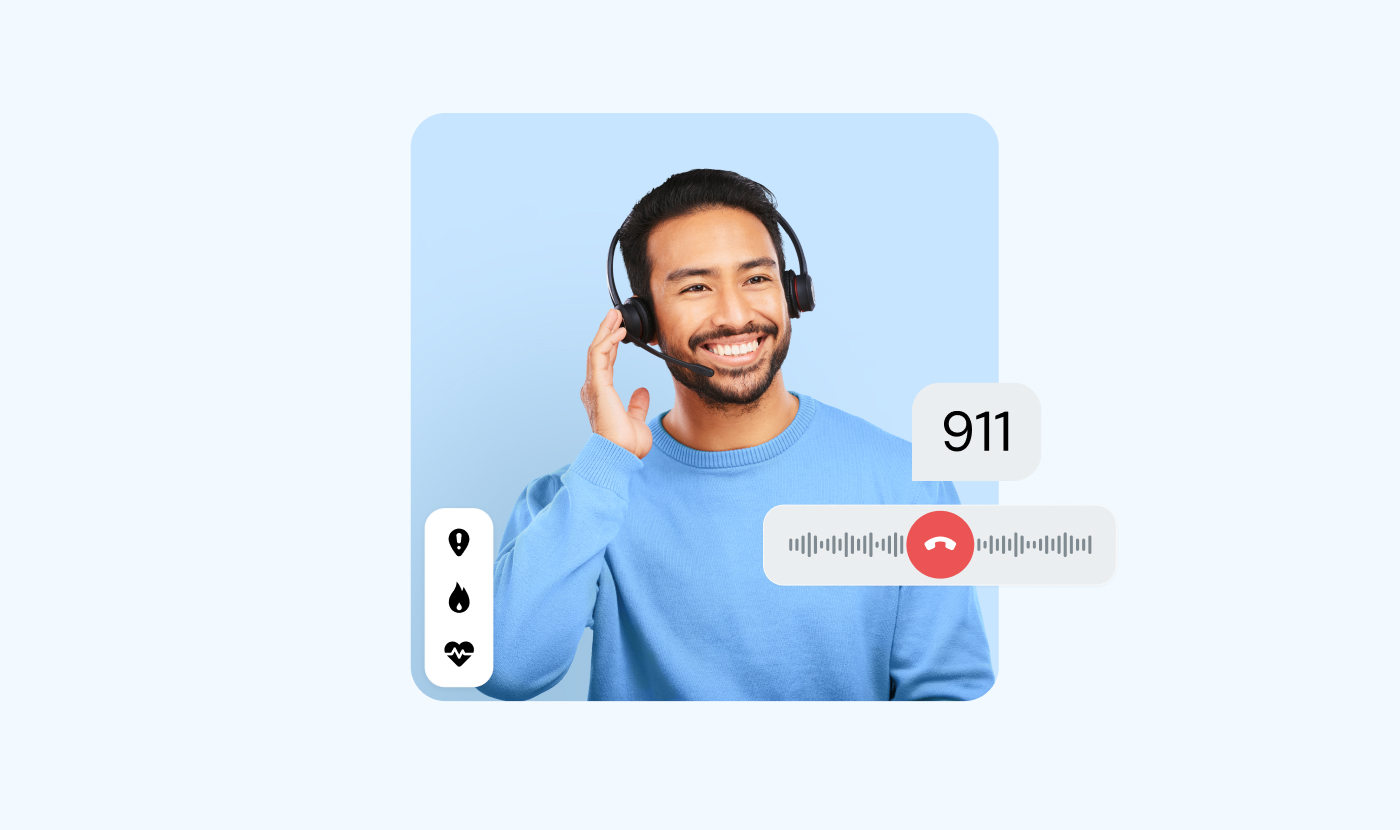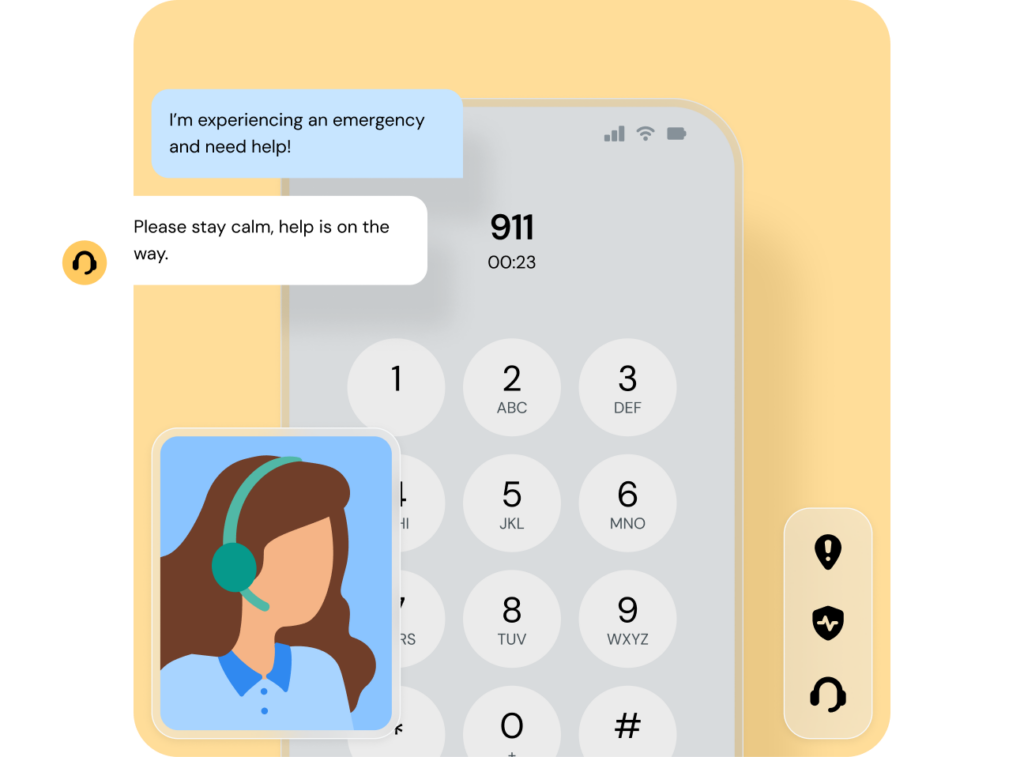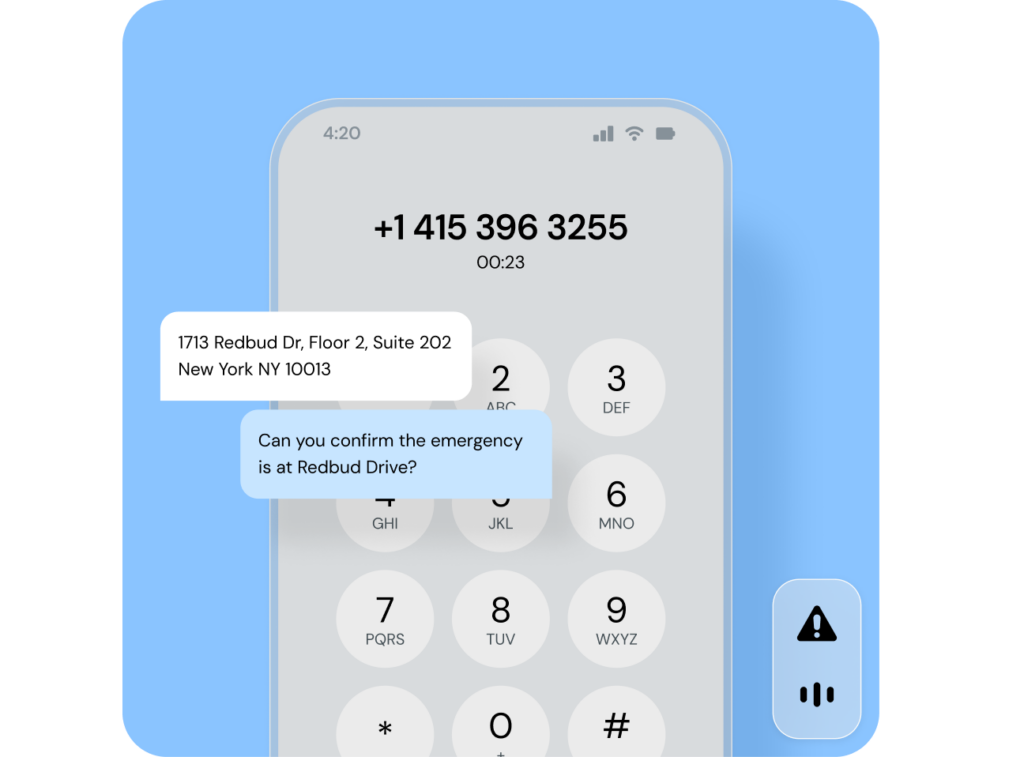Insights
Kari’s law and RAY BAUM’s Act: What the E911 laws mean and how to stay compliant

Insights

Learn how Kari’s Law and RAY BAUM’s Act have defined E911 laws in the U.S., and what your business needs to do to stay compliant.
The first 911 emergency call rang out in Haleyville, Alabama, on February 16, 1968, forever changing public safety communication. A simple three-digit number quickly became a lifeline connecting people in their most critical moments of need.
Unfortunately, a series of tragic incidents exposed massive gaps in emergency response systems, pushing lawmakers and safety experts to develop more robust communication protocols.
Today, two statutes – RAY BAUM’s Act and Kari’s Law – exist to ensure emergency calls aren’t just easy to place, but that first responders receive precise location details. Both regulations inform the enhanced 911 (E911) system in the United States. They aim to remove barriers when reaching a Public Safety Answering Point (PSAP) and tie 911 calls to a precise location for faster response times.
In this guide, we’ll explore their origins, dissect key requirements, and provide a clear roadmap to ensure compliance.
Kari’s Law requires multi-line telephone systems (MLTS) to support direct dialing to 911 without prefixes or extra codes. This critical regulation mandates businesses to configure their phone systems to provide direct access to emergency services.
Organizations must ensure that anyone can quickly dial 911 from any phone, eliminating potential barriers that could delay life-saving response times.
Kari’s Law also requires notification support for MLTS, which is mandatory for any system not requiring hardware or software development to support this feature and meet compliance requirements. Plus, it’s mandatory for new MLTS deployments to have notification of emergency calls delivered to a central location at the facility where the system is installed, or to another person or organization regardless of location.

The emergency call notification must include details that a 911 call was made, the emergency response location provided to the PSAP, and the callback number of the caller when technically feasible. The goal is simple: eliminate any technical obstacles that could prevent or delay emergency communication. The Federal Communications Commission enforces this regulation to ensure compliance is maintained.
Organizations, businesses, and government agencies alike must meet these standards, as compliance is crucial for protecting employees, customers, and visitors in any workplace setting.
In 2013, Kari Hunt Dunn was tragically murdered in a motel room by her estranged husband. Her nine-year-old daughter attempted to call 911 multiple times but failed due to the motel’s phone system requiring a prefix to dial out. In many places like hotels or larger businesses, you have to dial one or even multiple digits like 9 or 333 to place an outside call. Kari Hunt Dunn’s daughter didn’t know this, so when she tried to dial 9-1-1 without the prefix, the call never went through. The front desk was also never notified of the emergency call attempts.
This heartbreaking incident sparked a nationwide effort to ensure direct 911 access in multi-line telephone systems.
The law mandates specific technical configurations for MLTS. This means end users can dial 911 directly from any phone, regardless of the system’s complexity.
The MLTS must automatically alert a central location or designated personnel when a 911 call is made. This notification requirement must include: confirmation that a 911 call was initiated, a valid callback number, and the location of the calling party.
Compliance applies to any facility using multi-line telephone systems, whether on-premises or off-site, like corporate office buildings, hotels, hospitals, college campuses, and more.
RAY BAUM’s Act, the other important statute in E911 regulation, builds on this.
The acronym RAY BAUM stands for “Repack Airwaves Yielding Better Access for Users of Modern Services” and also honors Ray Baum, a lawyer and congressman who championed telecommunications improvements.
Section 506 of the act is designed to save lives by ensuring emergency responders can quickly locate the calling party in distress with their dispatchable location information.
But what exactly is a “dispatchable location?”
Think of it as the most precise way to describe your location, so that first responders can quickly and efficiently find the person in distress. It’s not just the street address of the calling party, but includes additional information like floor number, room number, or specific area within a building.
Imagine a large office complex: If someone calls 911 from the 14th floor, west wing, room 1427, emergency services need to know exactly where to go.

The law applies to virtually every type of technological platform: wired phones, wireless devices, VoIP systems, and even softphones, including 911 calls from MLTS.
If a device can make a call, it falls under RAY BAUM’s Act. For MLTS specifically, this means that any type of device (wired, wireless, on-premise, remote, etc.) that connects to an MLTS has to comply with RAY BAUM’s Act.
Key requirements include:
With 240 million 911 calls made annually, this law aims to eliminate critical minutes lost in trying to pinpoint an exact location during emergencies.
RAY BAUM’s Act and Kari’s Law work together to make emergency response systems more timely and effective.
Kari’s Law tackles the first critical step: making sure anyone can dial 911 directly from a phone system – no access codes, no delays. It also ensures that security, reception, or other designated staff are notified immediately when someone dials 911.
The RAY BAUM’s Act takes the next step in emergency response by ensuring responders receive precise location details – like floor, suite, or exact room number – so they know exactly where to go.
Together, these laws form a critical lifeline in emergency response protecting employees, customers, and visitors in workplaces nationwide.
Non-compliance with RAY BAUM’s Act and Kari’s Law can mean life-or-death delays in emergency response. Take a look at these real-world scenarios:
These risks intensify in hybrid workplaces where employees move between corporate and remote settings, making accurate location tracking even more essential. That’s why it’s important to consider nomadic location management as part of your E911 setup as well.
Non-compliance also carries additional risks for companies and organizations. For one, failure to comply can lead to serious penalties and hefty fines.
Keep in mind that certain government benefits are also tied to meeting compliance standards.
Plus, poor emergency communication could result in employees or visitors filing civil lawsuits.
And news of safety failures spreads fast, damaging employee trust and customer confidence.
All in all, there are a multitude of reasons why you should ensure E911 compliance – and it’s not as complicated as it might seem at first.
Ensuring compliance with RAY BAUM’s Act and Kari’s Law is more straightforward than you may think. Organizations can meet these life-saving requirements with a few key steps – without high costs or hassle, especially when your voice and E911 services come from the same provider. While your company is liable if you don’t comply with the regulations, trusted partners cannot only make sure that your telecom stack meets all the requirements, they’re also there to guide and support you.
Aside from these measures, take additional steps to support first responders. Make sure first responders can enter your building by providing elevator, door, and keycard access. Develop comprehensive emergency response policies that go beyond basic technological compliance, and keep up to date with state and local regulations.
Want to ensure full compliance? Download our comprehensive E911 compliance guide to safeguard your organization and streamline emergency response.
When it comes to staying compliant with Kari’s Law and RAY BAUM’s Act, you should work with a provider that puts public safety first.
In a crisis, the last thing you should worry about is if your 911 call will make it through to emergency services, and if first responders will quickly find where they need to go. That’s why at Sinch all our phone numbers, voice, and unified communications include availability to our E911 services and are fully compliant with Kari’s Law and RAY BAUM’s Act. Our portal and APIs also help you update addresses quickly and easily, including options for delivering dynamic location at call-time. We are also one of three entities with a tested and certified E911 solution for Microsoft Teams.
Our emergency services – that run on our owned-and operated network – include 911 nomadic location management, precise routing, and dependable call transport, using reliable network infrastructure.
At Sinch, our goal is to seamlessly connect emergency services with trustworthy, robust, and reliable 911 solutions to handle any emergency, so you can offer the best protection for your company and your employees.